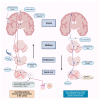Pruritus in Uremic Patients: Approaches to Alleviating a Common Symptom in Chronic Kidney Disease
- PMID: 40724504
- PMCID: PMC12298487
- DOI: 10.3390/life15071001
Pruritus in Uremic Patients: Approaches to Alleviating a Common Symptom in Chronic Kidney Disease
Abstract
Chronic kidney disease-associated pruritus (CKD-aP) is a distressing symptom that affects both dialysis and non-dialysis patients, significantly impairing their quality of life. Despite its multifactorial pathophysiology, no gold-standard treatment has been established. This review explores various therapeutic options and evaluates their effectiveness based on recent clinical studies and meta-analyses. Therapies targeting novel mechanisms have evolved in recent years. Difelikefalin, a κ-opioid receptor agonist, represents a breakthrough in systemic treatment, demonstrating efficacy with a favorable safety profile. Another opioid-based therapy, nalfurafine, has shown notable symptom relief in multiple clinical studies, with a low risk of abuse. Sertraline, an antidepressant, offers another alternative, although its delayed onset remains a limitation. Nonpharmacologic approaches are also evolving. Phototherapy, particularly UV-B therapy, modulates the immune response, reduces inflammation, and effectively alleviates itching in hemodialysis patients. Personalized treatment strategies are crucial, as responses vary among patients. Further research, including comparative and long-term studies, is essential to refine treatment algorithms and improve patient outcomes. By integrating new pharmacologic and nonpharmacologic options, CKD-aP management is shifting toward a more tailored and effective approach that addresses the individual needs of each patient.
Keywords: chronic kidney disease; pruritus; uremic patient; uremic pruritus.
Conflict of interest statement
The authors declare no conflicts of interest.
Figures










Similar articles
-
The Black Book of Psychotropic Dosing and Monitoring.Psychopharmacol Bull. 2024 Jul 8;54(3):8-59. Psychopharmacol Bull. 2024. PMID: 38993656 Free PMC article. Review.
-
Management of urinary stones by experts in stone disease (ESD 2025).Arch Ital Urol Androl. 2025 Jun 30;97(2):14085. doi: 10.4081/aiua.2025.14085. Epub 2025 Jun 30. Arch Ital Urol Androl. 2025. PMID: 40583613 Review.
-
Systemic pharmacological treatments for chronic plaque psoriasis: a network meta-analysis.Cochrane Database Syst Rev. 2017 Dec 22;12(12):CD011535. doi: 10.1002/14651858.CD011535.pub2. Cochrane Database Syst Rev. 2017. Update in: Cochrane Database Syst Rev. 2020 Jan 9;1:CD011535. doi: 10.1002/14651858.CD011535.pub3. PMID: 29271481 Free PMC article. Updated.
-
Pharmacological interventions for pruritus in adult palliative care patients.Cochrane Database Syst Rev. 2013 Jun 9;(6):CD008320. doi: 10.1002/14651858.CD008320.pub2. Cochrane Database Syst Rev. 2013. Update in: Cochrane Database Syst Rev. 2016 Nov 15;11:CD008630. doi: 10.1002/14651858.CD008630.pub4. Update in: Cochrane Database Syst Rev. 2016 Nov 16;11:CD008320. doi: 10.1002/14651858.CD008320.pub3. PMID: 23749733 Updated.
-
Systemic pharmacological treatments for chronic plaque psoriasis: a network meta-analysis.Cochrane Database Syst Rev. 2021 Apr 19;4(4):CD011535. doi: 10.1002/14651858.CD011535.pub4. Cochrane Database Syst Rev. 2021. Update in: Cochrane Database Syst Rev. 2022 May 23;5:CD011535. doi: 10.1002/14651858.CD011535.pub5. PMID: 33871055 Free PMC article. Updated.
References
-
- Molina P., Ojeda R., Blanco A., Alcalde G., Prieto-Velasco M., Aresté N., Buades J.M., Simó V.E., Goicoechea M., Pérez-Morales R.E., et al. Etiopathogenesis of chronic kidney disease-associated pruritus: Putting the pieces of the puzzle together. Nefrología (Engl. Ed.) 2023;43:48–62. doi: 10.1016/j.nefroe.2023.03.015. - DOI - PubMed
-
- Manuel Buades J., Figueras-Nart I., Goicoechea M., Sánchez Villanueva R.J., Serra-Baldrich E. Information and consensus document for the diagnostic and therapeutic management of pruritus associated with chronic kidney disease in patients on haemodialysis in Spain. Nefrología (Engl. Ed.) 2024;44:465–474. doi: 10.1016/j.nefroe.2024.07.003. - DOI - PubMed
Publication types
LinkOut - more resources
Full Text Sources

